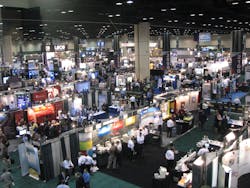LABORATORY-BASED LIFE SCIENCE: Pittcon 2012: Life sciences flourishes in labs
Although Pittcon 2012 (March 11–15; Orlando, FL) was smaller than the last Pittcon event I attended, there were still plenty of offerings for biophotonics watchers. The annual event focuses on laboratory science and equipment, and this year gave its Pittsburgh Spectroscopy Award to single-molecule microscopy and spectroscopy pioneer W. E. Moerner, who serves as Stanford University's Harry S. Mosher Professor of Chemistry.
The Pittcon 2012 opening plenary presentation featured Purdue University chemistry professor R. Graham Cooks demonstrating a portable mass spectrometer that he says doctors will someday use to identify cancerous liver tissue, analyze urine samples for molecular disease markers, and evaluate blood samples for drug effectiveness.
The conference program featured a bioanalytical track with dedicated sessions on breath analysis for medical diagnostics and on biomedical applications of NIR fluorescence, among other topics. But interesting bio-related topics were scattered throughout the conference; for instance, the sensing technologies program explored nanotechnology for microscopy and imaging. Another interesting offering: Anasys's presentation on Infrared-Coupled Atomic Force Microscopy (AFM-IR) for bio research.
Maybe all of this is why in the purchasing-intent study report that Laboratory Equipment magazine was circulating, five of the seven fastest lab growth areas were related to the biomedical field. When respondents were asked which lab technologies would likely grow the most in terms of technology, market, and applications, they picked bionanotechnology (61%), medical diagnostics (58%), biotech (54%), medical devices (50%), and imaging and analysis (50%).
The exhibit hall seemed to reflect this, too. Excitement at the NanoSight (Salisbury, England) booth stemmed from recent recognition of exosomes as potential biomarkers (and corresponding dramatic increase in exosome research)—and NanoSight's reportedly unique, photonics-enabled ability to facilitate such work with nanoparticle tracking analysis (NTA). Circulating levels of exosomes have been found to be elevated in various disorders, including cancer, atherosclerosis and coronary artery disease, hematological and inflammatory diseases, and diabetes.
A number of companies introduced new products at the event, including Horiba, which offered a sneak preview of its new VS-7000+ Mini CCD spectrometer for OEMs. The miniature cube promises unmatched dynamic range for UV-VIS-NIR applications, including fluorescence, emission, absorbance, reflectance, and other low-light apps, and features a concave grating to reduce stray light in the UV region.
StellarNet introduced an adjustable digital microscope accessory for its small spectrometers that plugs into a PC via the USB port and allows the capture of images to correlate with spectral data. (Subsequently, by the way, B&W Tek announced its 18th patent: A spectroscopic probe that mounts directly to a standard microscope, with minimal alteration to the microscope's optical path. And Energetiq Technology showed off its EQ-99 LDLS laser-driven light source, a highly stable, ultra-bright source of broadband deep ultraviolet, visible, and near-infrared light that promises a lifetime 10 times that of conventional scientific lamps.)
MIRTHE (Mid-Infrared Technologies for Health and the Environment), a National Science Foundation Engineering Research Center (ERC) headquartered at Princeton University (Princeton, NJ), was on hand to talk about its work, and to host a startup associated with the center: TAG Optics. The company promoted its TAG Lens, "The fastest focusing lens in the world," according to CEO Christian Theriault.
About the Author

Barbara Gefvert
Editor-in-Chief, BioOptics World (2008-2020)
Barbara G. Gefvert has been a science and technology editor and writer since 1987, and served as editor in chief on multiple publications, including Sensors magazine for nearly a decade.
